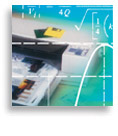|

Electrophotography (EP)
Electrophotography, or EP, is the oldest of the non-impact
printing technologies, having been invented in the mid 1930's by
Chester Carlson. Electrophotographic printing is also often referred
to as Xerography (meaning dry writing) and/or laser printing.
Technically the term "laser" refers to the specific light exposure
technology used in the process, but more often than not, the term
laser printer is generically used to describe any
electrophotographic printing system (such as an LED printer,
regardless of its exposure technology.
Electrophotography is the most complex digital printing
technology, consisting of two critical materials and seven process
steps.
Electrophotographic (EP) Printing Materials
- Toner
- Photoconductor (Often referred to as the photoreceptor)
Seven Process Steps:
- Charge
- Expose
- Development
- Transfer
- Fuse
- Clean
- Erase
The principal advantages of Electrophotography, or EP, over other
non-impact printing or digital printing technologies are:
- Excellent print quality for text, graphics, and pictorials
- Large speed range - products from 4 PPM to 1,000 PPM
The technologies and technical disciplines utilized in the
development of an EP system include: Mechanical Engineering
(Mechanism Design, Machine Design, Paper Handling Design, Fusing
System Design, Heat Transfer), Electrical Engineering (Digital
Hardware Design, Analog Design), Firmware Development, Software
Engineering, Physics (Electrostatics), Material Science, and Paper
Handling.
Torrey Pines Research (TPR) is the leading independent technical
authority in electrophotographic printing technology and the product
development of electrophotographic printing system products and
sub-systems.
In recent years, TPR has been called upon to extend the
technologies associated with Electrophotography to other industries
requiring controlled precision material deposition of dry powders
and liquids.
(Back to top)
Toner Development
Sub-system
The process of creating the toner image on the surface of the
photoreceptor is referred to as the toner development process. While
each of the seven steps of the EP process are critical to the proper
function of the system as a whole, it is often said that the most
critical step is the toner development step. Proper development of
the latent electrostatic image on the surface of the photoconductor
requires the careful integration of materials, electrostatics,
mechanics, and electronics.
The primary dry powder development technologies include the
following Dual Component Development (DCD) and Single Component
Development (SCD). The primary differences between these dry powder
development technologies are as follows:
- Dual Component Development (DCD) -
Characterized by the fact that the materials associated with the
development process are comprised of two constituents, the toner
and the carrier. The combination of the toner and carrier is
referred to as the developer material. The toner is the material
that ultimately comprises the final image, and is typically 5
microns to 10 microns in size and is composed of a thermal
plastic resin material with a colorant added together with a
number of other material additives used to optimize its
performance. The carrier is typically magnetically permeable,
approximately 4 to 10 times larger than the toner, and is used
to charge the toner via Tribo-electrification,
and transport the toner via its magnetic properties.
- Single Component Development (SCD) -
characterized by the fact that the material associated with the
development process only consist of the toner, the material that
ultimately comprises the final image.
(Back to top)

|

